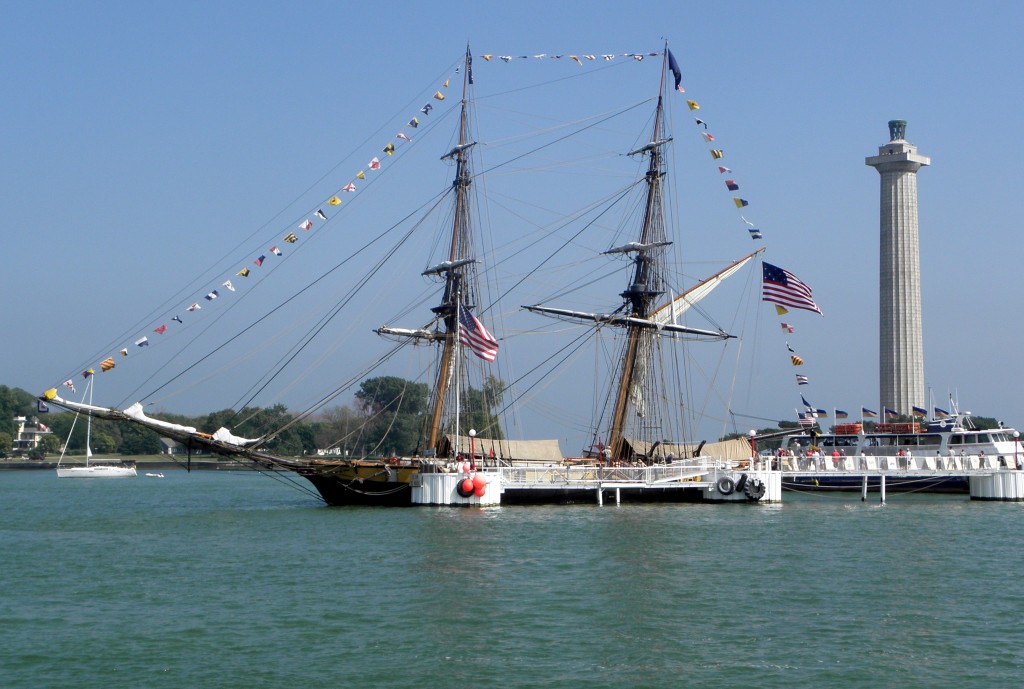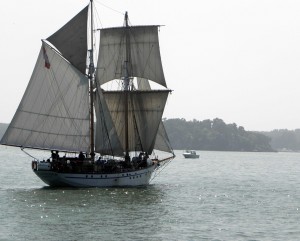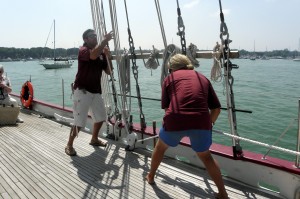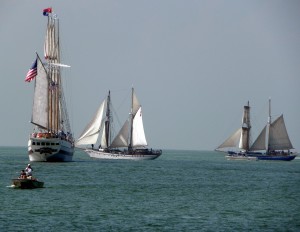Listen to the story:
The Battle of Lake Erie – Karen Schaefer by Great Lakes Echo
By Karen Schaefer
Additional links:
- NPS Perry Monument
- Battle of Lake Erie Bicentennial
- Listen to the Battle of Lake Erie on a live webstream at Port Clinton Radio 11:30 a.m. EST today.
Read script below:

Replica of Perry’s flagship Niagara with Perry Monument in background. Photo: Karen Schaefer
SCHAEFER: A toxic blue-green algae bloom drifting around the Lake Erie Islands this Labor Day weekend did nothing to deter tens of thousands of visitors t Put-in-Bay, Ohio. They were anxious to see the fleet of tall ships re-enacting the 1813 Battle of Lake Erie. The bicentennial celebration has drawn people from across the U.S. eager to relive an event which shaped the future of the Great Lakes – and the nation.
AMBI: Ready on your throat? Ready on the throat! Ready on the peak? Ready on the peak! Okay, haul away together. Haul away together! [sounds of sails being hauled aloft, run under:]
SCHAEFER: On the tall ship Hailie & Matthew out of Eastport, Maine, the crew is hoisting the sails on this 21st century 100-foot, two-masted schooner. It’s a nearly windless day in Put-in-Bay, the harbor where 200 years ago, Commodore Oliver Hazard Perry gathered nine newly-built vessels to sail out and accost the invading British fleet. There’s no such threat today, but in keeping with the spirit of the event, Seaman Patrick Donahue sends a warning shot across the bows of an approaching Canadian vessel, the Pathfinder, a square-rigged brigantine out of Toronto.
AMBI: Fire in the hole! Fire in the hole! [sound of cannon blast, followed by applause, under:]
SCHAEFER: Among the passengers is Lee Merkle, who came all the way from his home in Florida to photograph the ships. He’s been a sailor himself for 48 years.
MERKLE: Fifteen hundred miles. [laughs]
SCHAEFER: Oh my gosh, why?
MERKLE: Because of the tall ships, that’s it, that’s the reason. And to see some kids. They all sail.
SCHAEFER: So it’s in the blood.

Canadian brigantine, Pathfinder in front of Gibralter Island. Photo: Karen Schaefer
MERKLE: Oh, yeah.
SCHAEFER: Merkle says he’s landed a special prize — a place on one of the boats that will accompany the fleet, to the site of the original battle far from land, about 11-miles west.
MERKLE: So I plan to go out on a power boat just to get the photographs. So that way I can photograph every ship. Looking forward to it.
SCHAEFER: Captain Shawn Melillo says the Hailie & Matthew will take part in today’s battle on the American side. Melillo says the logistics for staging this re-enactment are surprisingly complex.
MELILLO: I guess there are eight different plans based on the way the wind direction is, because it was a battle that was fought where everybody was hove to, so they could stay stationary, kind of jockey into position, and then blast away. We’re going to be the U.S. vessel the Porcupine. At one point in the Great Lakes she ran for it while she was being attacked by four or five British ships, got away. And then after the battle the re-enactment is taking to place to represent, she was the hospital ship.
AMBI: Sounds of ship, fade out, bring up Perry Monument ambi, under:

Hauling up the sails on the Hailie & Matthew. Photo: Karen Schaefer
SCHAEFER: If your memory of the history of the War of 1812 is a little hazy, Steve Roberts says that’s not surprising. Roberts is a National Park ranger at the Perry Monument in Put-in-Bay.
ROBERTS: The War of 1812 is often referred to as the forgotten war, because you didn’t see borders change. It kind of gets snuck in here between the Revolutionary War a little bit earlier and the American Civil War a little bit later.
SCHAEFER: Roberts says the War of 1812 was started because the British, which still held Canada, had continued to harrass the newly-independent United States, blockading shipping and impressing captured Americans as unwilling seaman. The most famous battles of the war were the burning of Washington, D.C. in 1814, which largely destroyed the nation’s capitol, and the Battle of New Orleans, in 1815, which finally ended the conflict. In between, Roberts says fighting in the Great Lakes, America’s new frontier, had until 1813 resulted in a stalemate, with both sides attempting and failing to invade each other across the border. Roberts says the Battle of Lake Erie was a major turning point.
ROBERTS: Before Oliver Hazard Perry and his American ships were built in Erie, Pennsylvania, the British were uncontested on the lake. They could move their supplies with their ships along the lake without any problem. When the Americans got out here, they were kind of stuck. So, before the Battle of Lake Erie started up at Fort Malden, Amherstburg, Ontario, they were down to what they says was a half day’s worth of rations, they were out of supplies. And they were forced to either come out and fight or surrender the fort and head back east.
SCHAEFER: So on September 10, 1813, the two forces met on Lake Erie. Commodore Perry

Preparing to send a shot over the bow. Photo: Karen Schaefer
was just 27 years old. So, too, was the commander of the British fleet, Robert Heriot Barclay. Many sailors aboard both American and British vessels were also very young, some only 10 or 11-years old. And at least one was a woman.
KATHY HOLBROOK: My name is Jane Winfrey Holbrook. Winfrey. And I was called Wince September 10, 1813. For you see, I did the unthinkable. I dressed as a man and I fought as a man!
SCHAEFER: Kathy Holbrook is a National Park ranger who portrays Jane Winfrey Holbrook, a young woman from Erie, Pennsylvania who, along with her two brothers, enlisted in the United States Navy to fight the British. Holbrook tied up her long hair and dressed in men’s clothing, determined to revenge her father, taken for a seaman by the British Navy and never seen again. During the battle, both of her brothers died. But Holbrook, who served on Perry’s flagship the Lawrence, badly damaged in the battle, was one of those who transferred with Perry to the Niagara.
HOLBROOK: Suddenly Perry is at my side, saying, Wince, come with me, lad, come with me! All is certainly lost, we are surrendering, the American flag comes down, Old Glory, the Stars and Stripes. And the flag that he carries, not the Stars and Stripes, because we have not surrendered. And no, he never gave up the ship.
SCHAEFER: Perry’s famous flag, Don’t Give Up the Ship, flew on the Niagara during the rest of the battle. U.S. firepower and a lucky wind won the battle for the Americans. But the cost was high. One in four men on each side either died or were wounded. Many lost arms or legs. Officers from both sides were buried on South Bass Island, but ordinary seamen were wrapped in shrouds and consigned to the lake. After the battle, Perry penned a note to his commanders, “We have met the enemy and he is ours.”

The Windy, and Canadian square-riggers the Pathfinder and the Playfair. Photo: Karen Schaefer
AMBI: Sound of visitors to Perry Monument, under:
SCHAEFER: National Park Service ranger Steve Roberts says the Battle of Lake Erie essentially brought the war in the Great Lakes region to a close.
ROBERTS: What’s really came out that’s important both to United States and Canada from the War of 1812 is the long-lasting international peace between our two countries. From up here on the observation deck, we talk about the islands and what they see. But I ask them what they don’t see. They don’t see patrol boats going back and forth with armed guards keeping people from going back and forth. It is a peaceful place along that border. And that’s something pretty special.
SCHAEFER: Jim Caanan, a construction worker from nearby Fremont, Ohio, would agree. Dressed in white cotton trousers and shirt, he’ll be re-enacting the part of Peter Fisher, a seaman aboard the U.S. Brig Caledonia. And he spent 285-dollars for the privilege.
CAANAN: I have one line. ‘Hark, I hear the cannons roar.’
SCHAEFER: What made you want to do this?
CANAAN: Why not? Chance of a lifetime. To be on these tall ships, to re-enact the battle of 200-years ago, with cannons going off? Sure.
SCHAEFER: The re-enactment of the Battle of Lake Erie takes place at noon today with 15 tall ships and crew members from around the country participating. Weather permitting, you’ll be able to watch the battle take place via a live internet stream from Port Clinton radio station WPCR. For Great Lakes Echo, I’m Karen Schaefer.
My 4th great grandpa was in the war of 1812 and fought on one of ships any one know how I can find out what one he was on his name Benjamin Jones IV
David Jackman
Jackman4201 @outlook.com
Hi Karen, here’s a great list of tall ships some with the same rigging types that visited the Erie reenactment.
I thought it was great. For sure the authorities were overwhelmed with the number of boats and I heard it caused a delay in the event. However, it was fun and neat to see. Didn’t see any algae out there. We came across the Lake from Michigan.
I had a friend on one of the ships. He dressed in period clothing and it is unfortunate that this wasn’t a requirement to participate. Those in t-shirts and shorts looked ridiculous as “re-enactors.” Also all the other boats going out and crowding around those ships, ignoring the police and the Coast Guard just to get in on the action is shameful. What a poorly organized event. For those looking on it didn’t look like much, nothing to be extremely proud of. We could have missed it and there’s nothing to show we would be sorry we did.
What a joke this was, even the Actor portraying Perry wasn’t even in a proper Naval Uniform. I’m an 1812 Naval Re-enactor from a well established and respected unit. We were not even invited to this event, because it was strictly a money grab, charging 285-975 depending on the “rank” you wished to portray. I have been doing this for 15 years and have proper uniforms and artillery and small arms training. Not to mention “Perry being motored across to the other ship”, we would have given everything to row him across to the Niagara.
–A Member of the Provincial Marine of Amherstburg–
Hi I am seaman Skelhorn captain of my canoe we braved the seas this morn only to turn back and fight the battle from the banks of the Portage at the Bait Shop with a live musician playing all afternoon we quite enjoyed ourselves as we watched the other louvers come back in seasick an bedeviled. I can;t wait for the next hundred years to see that battle